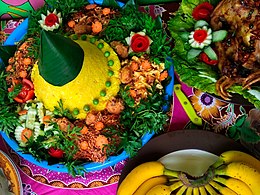
Back ৰেনডাং Assamese Rendang BAN Rendang BCL Rendang Czech Rendang German Rendang Spanish رندانگ Persian Rendang French Rendang ID Rendang Italian
 Authentic Minangkabau (Padang), Indonesia, beef rendang has a dark colour, with very little liquid content. | |
| Alternative names | Randang (in Minangkabau) |
|---|---|
| Course | Main course |
| Place of origin | Indonesia[1][2] |
| Region or state | West Sumatra[3] |
| Associated cuisine | Indonesia,[4] Malaysia, Singapore, Brunei |
| Serving temperature | Hot or room temperature |
| Main ingredients | Meat (beef, lamb or goat), coconut milk, chilli, ginger, galangal, turmeric, lemongrass, garlic, shallot |
| Variations | Chicken rendang, duck rendang, liver rendang, spleen rendang |
 |
| This article is part of the series on |
| Indonesian cuisine Masakan Indonesia |
|---|
|
|
Rendang (/rɛnˈdæŋ/; Indonesian pronunciation: [ˈrəndaŋ]) is a Minangkabau dish. It is a rich meat-based dish that is slow-cooked, braised in coconut milk, and seasoned with herb and spice mixture over a period of several hours. As the liquids evaporate, the meat turns dark brown and tender, caramelizing and infusing it with rich flavours.[5][6]
It originated from the Minangkabau region in West Sumatra, Indonesia.[7] It has spread across Indonesian cuisine to the cuisines of neighbouring Southeast Asian countries such as Malaysia, Singapore, Brunei and the Philippines.[2] As the signature dish of Minangkabau culture, rendang is traditionally served at ceremonial occasions to honour guests during festive events, such as wedding feasts and Lebaran (Indonesian popular words for both Eid al-Fitr and Eid al-Adha).[8] Rendang is also traditionally served among the Malay community in Indonesia, Malaysia, Singapore and Brunei, as well as the Maranao in the Philippines.[9]
Rendang is officially recognised as one of Indonesia's national dishes. Six types of rendang preparations have also been designated as intangible cultural heritage by the Indonesian Ministry of Education and Culture. A broad survey in 2011 placed beef rendang as the most delicious dish in the world.[10][11]
- ^ Keating, Sarah (11 June 2018). "How an outrage over crispy chicken united South-East Asia". www.bbc.com. Retrieved 11 October 2020.
- ^ a b Taylor, Jean Gelman (2003). Indonesia: Peoples and Histories. New Haven and London: Yale University Press. pp. 46. ISBN 0-300-10518-5.
- ^ "Should chicken in rendang curry be crispy? Masterchef U.K. sparks debate". Canoe. Associated Press. 3 April 2018. Archived from the original on 5 April 2018. Retrieved 5 April 2018.
The curry (rendang), which originates from West Sumatra in Indonesia, is popular in Malaysia, Indonesia, Singapore, Brunei and southern Thailand.
- ^ Gita Amanda (5 July 2020). "Antropolog: Rendang Bukan Cuma Makanan Tapi Identitas Budaya". www.republika.com (in Indonesian). Retrieved 18 October 2020.
- ^ Holzen, Heinz Von (15 September 2014). A New Approach to Indonesian Cooking. Marshall Cavendish International Asia Pte Ltd. ISBN 978-981-4634-95-3.
- ^ Kautsar, Muthi Achadiat (2 September 2018). "Why beef rendang is the right food to send to natural disaster victims". The Jakarta Post. Retrieved 10 December 2019.
- ^ Owen, Sri (1993). The Rice Book. Doubleday. ISBN 0-7112-2260-6.
- ^ Lipoeto, Nur I; Agus, Zulkarnain; Oenzil, Fadil; Masrul, Mukhtar; Wattanapenpaiboon, Naiyana; Wahlqvist, Mark L (February 2001). "Contemporary Minangkabau food culture in West Sumatra, Indonesia". Asia Pacific Journal of Clinical Nutrition. 10 (1). Blackwell Synergy: 10–16. doi:10.1046/j.1440-6047.2001.00201.x. PMID 11708602.
- ^ Cite error: The named reference
thomaswas invoked but never defined (see the help page). - ^ Tim Cheung (7 September 2011). "Your pick: World's 50 best foods". CNNGo. Archived from the original on 11 November 2012. Retrieved 19 May 2015.
- ^ "Fun Facts about Rendang As the World's Best Food - Indonesia Travel". www.indonesia.travel. Retrieved 23 September 2023.
© MMXXIII Rich X Search. We shall prevail. All rights reserved. Rich X Search